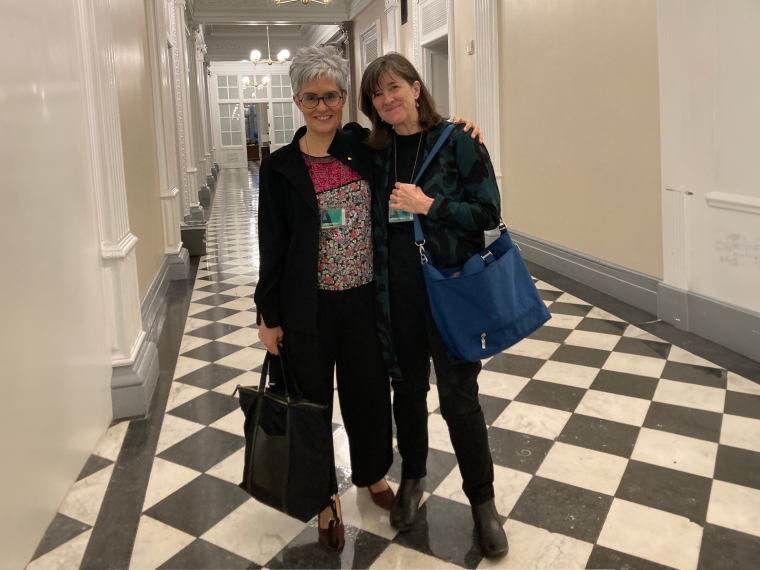The UArizona team developing NEPAccess – an online platform designed to aggregate, organize and analyze the thousands of documents created since the passage of the 1970 National Environmental Policy Act (NEPA) – participated in the first-ever White House Environmental Permitting Technology and Data Summit (Summit) on October 24, 2023.
The convening was hosted by the White House Council on Environmental Quality (CEQ), White House Office of Management and Budget and the Federal Permitting Improvement Steering Council. It included representatives from more than a dozen federal agencies, as well as private industry and nonprofit partners. Members of the NEPAccess team representing UArizona were the only academics invited to participate in the summit.
NEPA: The Missing Piece
NEPA, which was signed into law by President Richard Nixon on January 1, 1970, requires federal agencies to assess the potential environmental impacts of proposed projects prior to making decisions and taking action.
In 2011, conversations about NEPA between UArizona Udall Center research professor and professor in the School of Natural Resources and the Environment Laura López-Hoffman and UArizona law school dean Marc L. Miller led to the realization that there remained significant gaps in the implementation of the landmark law.
“There’s an untested hypothesis in this massive law that essentially has two parts,” says López-Hoffman. “The first part is the idea that having the government look before they leap and inform the public about the potential impacts of a project leads to better environmental decision-making. The second part is that by engaging the public and having the public give feedback about those potential actions we can have better social and environmental outcomes.”
The problem is that, historically, the Environmental Impact Statements (EIS) and Environmental Assessments (EA) generated under NEPA have not been housed in a single accessible repository. Each federal and state agency, private industry player and law firm that has engaged in the NEPA process since 1970 has been responsible for maintaining their own records and managing their own public comment processes.
This has made it difficult, if not impossible, for anyone to cross reference the impacts of a proposed project with similar efforts undertaken in the past. And, since EISs and EAs are also incredibly dense and extremely long – some top out around 1000 pages – they have proven ineffective at informing the public about the potential impacts of projects so they can participate in public comment periods.
The NEPAccess Platform
López-Hoffman and Miller set out on a mission that seemed simple enough on the surface: to locate all of the EISs created since 1970 and load them into a single, searchable database that can benefit all NEPA end users – whether those users are agency officials, developers, lawyers or the general public.
The team received their first National Science Foundation grant to begin building the NEPAccess platform in 2018 and have since secured other funds from the federal Udall Foundation and a handful of UArizona departments to help support their efforts over the past five years.
The result is a platform that is currently in beta testing that features nearly 18,000 records representing over 5000 individual EIS processes, including downloadable PDF documents for 65 percent of the EISs completed since 2000. Using a combined approach of manual and automated retrieval processes, more NEPA documents are being added to the platform everyday.
Despite not having a marketing budget, the platform has already seen more than 50,000 hits and currently supports over 700 registered users that include agency officials and private industry representatives.
The Benefits of Being ‘Outsiders’

Laura López-Hoffman poses with Jennifer Montoya (BLM) in the Eisenhower Executive Office Building of the White House complex following a CEQ reception.
Photo by Emily McGovern
In addition to participating in the White House Summit this fall, the NEPAcess team says they have been in conversation with a variety of entities that are interested in seeing the project reach its full potential. This includes representatives at several state and federal agencies, bipartisan members of congress, nonprofit foundations, a major research funding organization and a large private infrastructure consulting firm.
The team says that involvement in the Summit led directly to a number of follow-up conversations with potential partners and that those present at the White House convening seemed particularly excited about NEPAccess’ use of artificial intelligence (AI) in the platform, as well as the team’s focus on the user experience and interface.
NEPAccess Research Director Emily McGovern says that being the only academic team at the Summit offers them a unique perspective. Where each agency and industry player involved with trying to streamline the NEPA process is focused primarily on improving their internal workflows, the NEPAccess team are the only ones thinking about the law from a big-picture standpoint.
“We were outsiders in a way because we were in a different position,” says McGovern of the team’s standing as the only academics at the Summit. “We’re not trying to improve our own workflow. We’re trying to help the public. We’re trying to help these agencies. We’re trying to create a public good. And maybe that leads us to some different innovations because we’re looking at NEPA from a big-picture perspective.“
Building NEPAccess with Generative AI
Though the team has had tremendous success building the framework of the platform and populating it with EIS material in their first five years, those involved say they are still quite a distance from what they would consider a finish line.
The next phase of the project involves continuing to search for and add EIS documents to the platform, expanding that content to include EAs and sharpening the platform’s generative AI toolkit to help project leaders and staff develop new documents more efficiently and make the information in those documents more useful to the public. This includes using AI to produce summaries of key sections from the immense documents to help with the writing of new EAs and EISs.
Egoitz Laparra is the Natural Language Processing Lead for the NEPAccess team. His role is to create processes by which the platform can automatically find NEPA documents across the various nooks and crannies of the internet, pull those documents into the platform, and analyze them to extract key information so that they can be useful to the public.
“These data are very complex,” says Laparra. “These documents are huge, they contain a lot of information, a lot of science, and presenting these kinds of documents to the public is challenging.”
By augmenting their retrieval system with generative learning models, Laparra is hoping that NEPAccess will soon be able to locate the most important pieces of information in these immense documents and summarize them in a format that is digestible to the general public. His AI system, he says, will eventually enable users to initiate complex searches about NEPA documents and return comprehensive results that pull from multiple past projects simultaneously.
Though this might sound like a long-term goal, Laparra suggests that the implementation of these functions are closer than you might think. “I’m already working on a prototype for this,” Laparra says. “It is preliminary, but I’m already obtaining some results.”
The team is currently looking for long-term funding partners to support the next development phases of the project. They are also searching for additional partners to provide EISs and EAs not yet incorporated into the platform and end users to test the functionality of the system.




